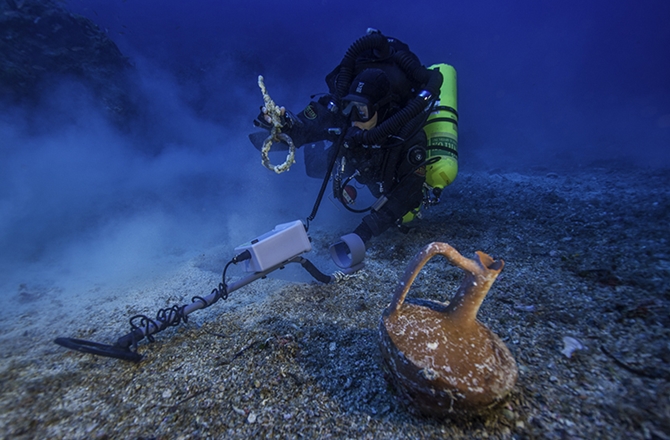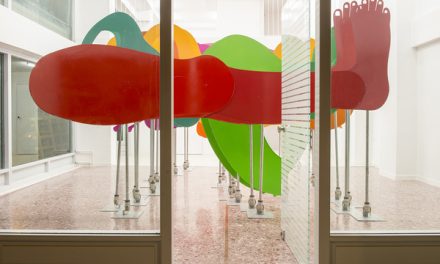2015 was another eventful year for archaeology in Greece with major archaeological discoveries, over the continent and underwater, which provided an array of insights into the endeavors of our ancestors and the legends of the ancient past.
22 Ancient Shipwrecks in Greek archipelago
A Greek-American expedition uncovered this Fall 22 shipwrecks around Greece’s Fourni archipelago in the eastern Aegean sea, which is covered in Roman, Classical, and Medieval ghost ships, proving that it was a major maritime commercial hub during ancient times.
Hailed as one of the top archaeological finds of 2015, the amazing discovery adds 12 percent to the total number of known ancient shipwrecks in Greece and include cargo that dates from the Archaic Period (700 to 480 B.C.) through the 16th century, including types of ancient amphorae never before seen on the seafloor.
Over a stretch of two weeks in September, tips from local fishermen and sponge divers led a team of marine archaeologists, from the American maritime research non-profit RPM Nautical Foundation and the Greek Ephorate of Underwater Antiquities, to the precise locations of 22 shipwrecks in a 17-square-mile area around the Fourni archipelago. Finding 22 shipwrecks in only two weeks is incredibly rare, but more discoveries in the area are likely—the team has surveyed only 5 percent of Fourni’s coasts, and local fishermen have given them many more tips.
Spectacular 3500-year-old Warrior’s Tomb
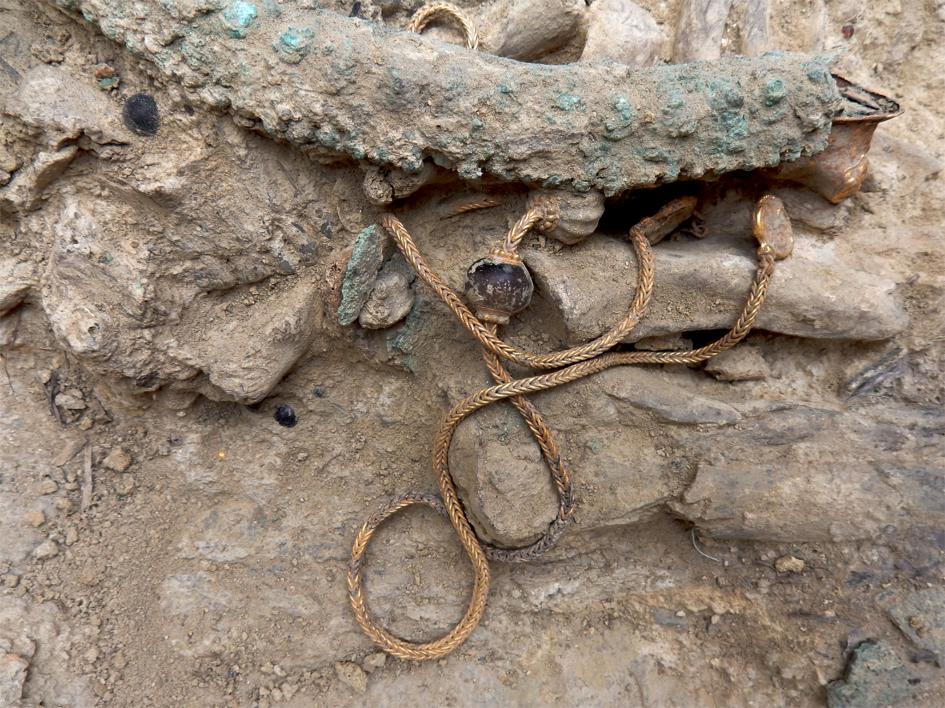 An intact tomb dating to roughly 1500 BC belonging to an ancient warrior was uncovered this Fall near the Mycenaean-era Palace of Nestor in southeastern Peloponnese. The tomb and its contents ranked as one of the most important discoveries in mainland Greece over the past 65 years.
An intact tomb dating to roughly 1500 BC belonging to an ancient warrior was uncovered this Fall near the Mycenaean-era Palace of Nestor in southeastern Peloponnese. The tomb and its contents ranked as one of the most important discoveries in mainland Greece over the past 65 years.
The discovery, brought to light by a University of Cincinnati team of archaeologists, is part of the Pylos Regional Archaeological Project (PRAP), a multi-disciplinary and long-time archaeological expedition established in 1990 to investigate the history of prehistoric and historic settlement in western Messinia (southeastern Peloponnese), and especially the area centered on the Bronze Age site known as the Palace of Nestor.
Archaeologists have identified more than 1,400 pieces, including an ornate string of pearls, signet rings, a bronze sword with a gold and ivory handle, silver vases and ivory combs whose quality testifies to the influence of the Minoans on the later Mycenaeans.
4,500 y/o underwater city
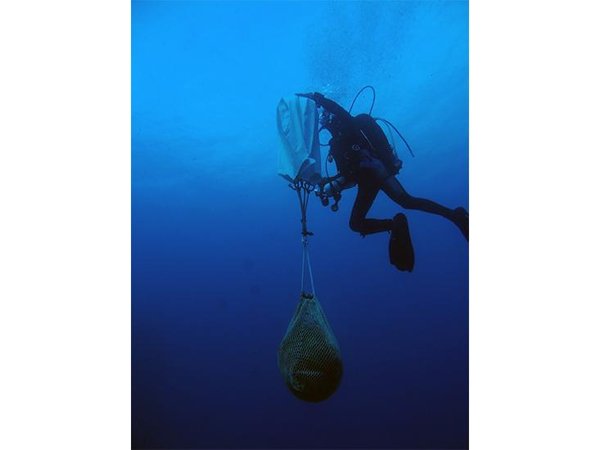 A large underwater ancient Greek settlement of the 3rd millennium BC was brought to light last summer in Argolis gulf, in eastern Peloponnese, by archaeologists of the University of Geneva and theGreek Ephorate of Underwater Antiquities under the auspices of the Swiss School of Archaeology in Greece.
A large underwater ancient Greek settlement of the 3rd millennium BC was brought to light last summer in Argolis gulf, in eastern Peloponnese, by archaeologists of the University of Geneva and theGreek Ephorate of Underwater Antiquities under the auspices of the Swiss School of Archaeology in Greece.
The settlement, located at a depth of 1m up to 3m, covers an area of around 12 acres, indicating a sprawling, heavily defended city dating as far back as 2500 B.C. The researchers employed the world’s largest solar-powered boat, the ‘PlanetSolar’, to aid in their search and found rectangular and circular building foundations as well as paved streets. Furthermore, they have located part of the settlement’s fortification and at least three large horseshoe-shaped foundations attached to the wall line, possibly part of the fortification that may have been towers.
New exploration of the Antikythera Shipwreck
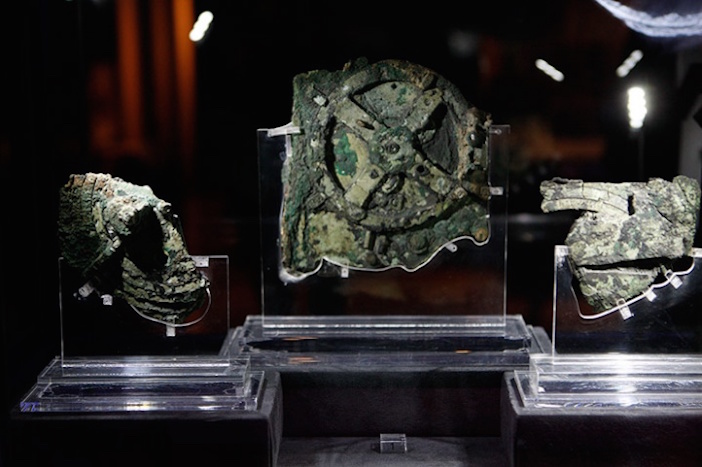 An international expedition has resumed research in late 2014 into one of the richest shipwrecks of antiquity, the Antikythera Shipwreck, a large Roman commercial vessel dubbed the “Titanic of the ancient world’ which sank with a luxury cargo of Greek treasures more than 2,000 years ago, off the remote island of Antikythera, in southern Greece. The expedition is considered to be one of the biggest underwater archaeological explorations in the world, according to New Scientist.
An international expedition has resumed research in late 2014 into one of the richest shipwrecks of antiquity, the Antikythera Shipwreck, a large Roman commercial vessel dubbed the “Titanic of the ancient world’ which sank with a luxury cargo of Greek treasures more than 2,000 years ago, off the remote island of Antikythera, in southern Greece. The expedition is considered to be one of the biggest underwater archaeological explorations in the world, according to New Scientist.
The wreck, believed to have been vessel that was carrying a luxury cargo of Greek treasures from the coast of Asia Minor west to Rome, was found by Greek sponge divers more than 100 years ago, who retrieved a treasure hoard which included bronze and marble statues, jewelry, furniture and the mysterious “Antikythera mechanism” associated to Archimedes— a complex, geared astronomical calculator known as the world’s oldest computer.
A project of the Greek Ministry of Culture and the Woods Hole Oceanographic Institution has allowed divers to return to the Antikythera shipwreck using a state-of-the art exosuit that acts like a wearable submarine. The more than 50 artifacts rescued this year include a beautiful intact amphora, a glass figure from a board game, a wine jug, a lead salvage ring and a giant bronze spear that would have belonged to a life-sized warrior statue.
Embraced neolithic-era skeletons
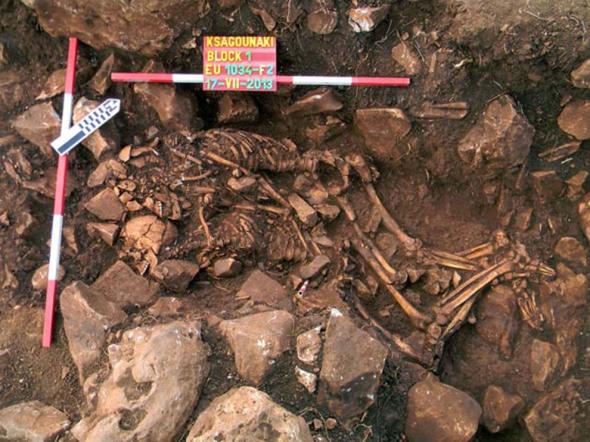 Last winter archaeologists in Greece came across a rare discovery. The Neolithic-era skeletons of a couple were found locked in an embracing position during excavations at the northern entrance of the Alepotrypa (“Foxhole”) Cave in southern Peloponnese, one of the largest Neolithic burial sites known in all of Europe. Fetal burials are not uncommon, but the double burial in fetal position is one of the earliest known examples of its kind. The embracing couple’s skeletons were dated with the C14 method to 3800 BC while their DNA analysis confirmed the remains were those of a male and female.
Last winter archaeologists in Greece came across a rare discovery. The Neolithic-era skeletons of a couple were found locked in an embracing position during excavations at the northern entrance of the Alepotrypa (“Foxhole”) Cave in southern Peloponnese, one of the largest Neolithic burial sites known in all of Europe. Fetal burials are not uncommon, but the double burial in fetal position is one of the earliest known examples of its kind. The embracing couple’s skeletons were dated with the C14 method to 3800 BC while their DNA analysis confirmed the remains were those of a male and female.
Protohistoric Linear B tablets
Over the summer of 2015, archaeologists in Greece uncovered more Linear B tablets in Laconia, at an excavation in a newly found Mycenaean palace on the Sparta plain. Linear B tablets is a very valuable discovery considering the fact that they come from a Protohistoric period of the Helladic area where written sources are scarce. It was estimated that the documents were written in the 14th century BC, thus making the documents older than the ones found in Pylos, in southwestern Peloponnese. The archaeological research was described by the Greek Ministry of Culture as one “of the most important systematic excavations in Greek Protohistory.” Ongoing excavations at Laconia’s sites in the southern Peloponnese are offering rare insight into Greece’s Protohistoric past, shedding light on life in the area during the 17th to 16th centuries BC.
3,300 year-old Mycenean tomb
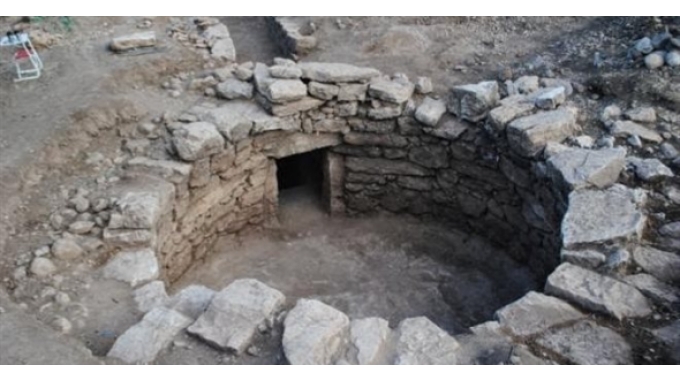 A 3,300 year-old vaulted Mycenaean tomb, found unplundered in early 2015 near Amfissa, central Greece, had kept its secrets in the dark for millennia, to reveal them only to science. The research showed that many attempted to raid the tomb, but none succeeded.
A 3,300 year-old vaulted Mycenaean tomb, found unplundered in early 2015 near Amfissa, central Greece, had kept its secrets in the dark for millennia, to reveal them only to science. The research showed that many attempted to raid the tomb, but none succeeded.
It is the first tomb of its kind to be found in the region and one of only a few that have been found untouched containing human remains and a hoard of treasures with valuable information regarding the habitation, burial customs, and possessions of the Mycenaeans in the 2nd millennium BC. The tomb was dome-shaped with a 9m corridor and a circular chamber, 6m wide and 3m high. Inside the tomb, archaeologists found pottery, jewelry, swords, precious stones and even a baby bottle. The quantity of finds shows the edifice was used as a tomb for more than two centuries. Among the finds of the dig, archaeologists agree that the most precious was a gold seal-ring with bull head decorations, similar to those found at Mycenae.
Cupid’s mirror & the wealthy priest
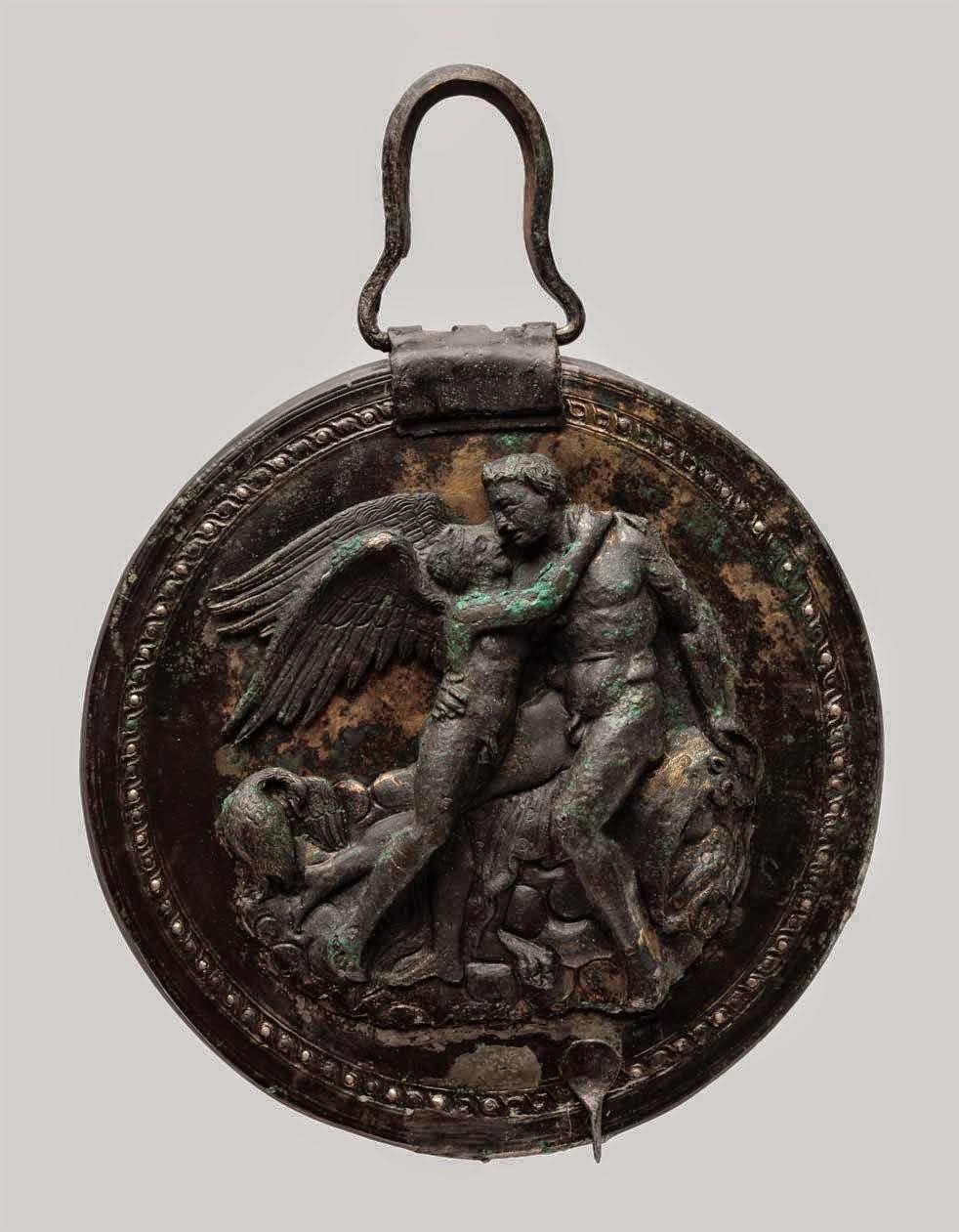 New discoveries from the ancient cemeteries of the Macedonian capital of Aegae (Vergina) did not disappoint. Archaeological research unearthed last year twenty-one more graves, six of which plundered. Inside the grave of a young girl (4th century BC), buried with gold ornaments including earrings, archaeologists found a bronze mirror depicting young Eros stretching his wings to catch the passionate god Dionysus who lies upon a piece of panther skin, in the shape of a virile young man. Inside a second grave, the dig uncovered the grave of a middle aged man lying on a daybed, without any weapons around him. Evidence suggests he was a contemporary of Alexander the Great and must have been a priest to Dionysus, as he was wealthy enough to be buried in his purple-dye clothing and decorated with a gold plated ivy wreath.
New discoveries from the ancient cemeteries of the Macedonian capital of Aegae (Vergina) did not disappoint. Archaeological research unearthed last year twenty-one more graves, six of which plundered. Inside the grave of a young girl (4th century BC), buried with gold ornaments including earrings, archaeologists found a bronze mirror depicting young Eros stretching his wings to catch the passionate god Dionysus who lies upon a piece of panther skin, in the shape of a virile young man. Inside a second grave, the dig uncovered the grave of a middle aged man lying on a daybed, without any weapons around him. Evidence suggests he was a contemporary of Alexander the Great and must have been a priest to Dionysus, as he was wealthy enough to be buried in his purple-dye clothing and decorated with a gold plated ivy wreath.
TAGS: ARCHEOLOGY | HERITAGE | HISTORY

